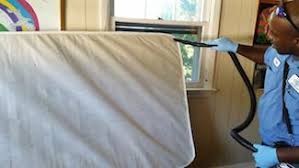Most people opt for pesticide treatments to eliminate bed bugs in their homes. If you are one of those people, you need to know that bed bugs have developed resistance to chemical-based treatments. It is in your best interest to find alternatives that do not rely on chemicals to get rid of these blood-sucking pests.
Bed bugs often wedge themselves in cracks and crevices within fabrics and other items around your home. This blog article explores everything you need to know about using your vacuum to get bed bugs out of their hiding spots. While a vacuum is not 100% effective against bed bugs, the information we share is helpful in your fight against bed bugs.
Table of Contents
Can Vacuuming Help With Bed Bugs?
The only way to succeed in your fight against bed bugs is to deploy all weapons, including the vacuum. Vacuuming is not the most effective method, but it is one part of the solution.
If you dealing with a budding bed bug problem, vacuuming will help to get rid of the infection. That said, it is wise to always incorporate other safe and more effective treatment methods in your fight against bed bugs. In a typical situation, vacuuming helps to:
- Get rid of large clusters of bed bugs swiftly
- Remove bed bug eggs that may have been left behind after treatment
- Control bed bugs in spaces or materials where the use of other treatment methods may be ineffective
- Remove dead bed bugs, exoskeletons and other debris, giving you a clean slate for follow-up inspections
When to use a vacuum against bed bugs
As I mentioned above, vacuuming can be helpful against bed bugs, but timing is a crucial aspect you must consider. Before using the vacuum, conduct a thorough investigation to spot infestation zones and bed bug hiding places. It is also essential to take note of infestation sizes and cluster zones.
The best time to use your vacuum against these critters is when they are undisturbed and organized in clusters. It would also be in your best interest to consider the size of the infestation around your home. If the infestation is advanced, a vacuum cleaner is not an option you need to consider.
Bed bugs are tiny, flat, oval-shaped critters that can squeeze into the most minute cracks and crevices around your home. If the infestation is large enough, these pests can wedge into spaces you would not even think of using your vacuum. You should also note that there is no guarantee that vacuuming will remove all the eggs. Bed bug eggs are coated with a transparent substance that sticks to most surfaces.
How to Vacuum Bed Bugs the Right Way
Using a vacuum cleaner against bed bugs is just the same as you would when cleaning your home, except for a few differences. You need to target the vacuum at specific spots because haphazard vacuuming helps to spread bed bugs. Here are a few tips to guide you in your vacuuming endeavor:
- Turn the vacuum cleaner on and point the crevice tool on the nozzle towards the infested area taking care not to ruffle the bed bugs. The bed bugs should ideally be clumped together, making suction easy.
- Run the crevice tool back and forth, taking care not to crush the bed bugs or eggs as they will stick to the surface, making it hard to vacuum. The bed bugs will also likely unclamp and crawl in different directions.
- Concentrate on hot zones like the corners of the bed, cracks, mattress seams, carpet and furniture around the bed, cracks and walls in proximity and even the ceiling corners.
- Scrape around the bed and floor for bed bug runaways. Do this repeatedly till you cannot spot any bed bug.
- Once done, remove the vacuum bag, seal tightly with tape and place it into a plastic bag for disposal. You may incinerate the bag to prevent re-infestation in other house zones.
- It may do you good to clean the vacuum attachments with soap and hot water as there is a chance that some bed bugs survived inside the vacuum cleaner. Do not splash water directly onto the vacuum cleaner.
- Isolate the vacuum cleaner for a while. If you can, use a different one in your regular cleaning.
- Repeat the process regularly.
Best Vacuum Brands against Bed Bugs
There are several high-performance vacuum brands for you to choose from. It may be hard to pick the best option for maximum results. Luckily, there are things you can look out for when purchasing one. A good choice is taking into account the accessibility to hot zones, ease, efficiency, suction power and compatibility to your unique problem. The resilience of bed bugs also calls for the washability of the vacuum to prevent re-infestation either inside the machine or in other areas of the house.
The accessories and attachments are the most significant assets to a bed bug vacuum. Some of the best ones offer a crevice tool for stubborn bed bugs and their eggs. Others provide unique solutions to these problems, like vibrating or rotating nozzles to dislodge bedbugs and their eggs from fabrics and surfaces. Some come with brush heads and extendable wands. Take care not to use faulty accessories that could lead to electrical failures.
You must also understand vacuum cleaner specifications to be able to pick one with a powerful suction. Bed bugs have unique shapes and body parts that adapt to sticking to the surfaces and fabric. Bed bugs’ eggs are also coated with ‘cement’, which attaches them to the surfaces. These eggs are tough to dislodge. Check the labels and packaging for more information on the vacuum’s suction.
Investing in vacuum cleaners with a detachable dustbin and bag is especially important. You would not want to spread the bed bug problems to other furniture and room. Disconnecting the bins or removing bags would make it easy to keep the bed bugs within the bags. These bins should also be big enough to allow repeated and longer vacuuming.
Vacuuming after bed bug treatment
Depending on your end game, you can vacuum after a primary bedbug treatment. This will majorly be getting rid of dead bed bugs and their eggs. Concentrate on the spots that had a significant infestation. After that, get rid of the vacuum bag after wrapping it in a tight plastic bag. Vacuuming could also help eliminate bed bugs that may have somehow survived the initial treatment.
Dealing with a vacuum after using it against bed bugs
The resilience of these bloodsuckers is such that they can live and reproduce even inside a vacuum. The same effort you put into getting rid of them could be why the infestation worsens. This is why follow-up cleaning on your vacuum cleaner is necessary. Even after wrapping the vacuum bag in a new plastic bag, some bed bugs or eggs could still be inside the vacuum cleaner. They may crawl out and start an infestation.
Take out the vacuum bag after every vacuuming session. Wrap it in a bedbug-proof plastic bug and discard it. Alternatively, you could incinerate the vacuum bag to ensure that the bugs and eggs have been destroyed. If your vacuum cleaner has a vacuum bin, take it outside, empty the contents into a plastic bag, seal it tight and discard.
Storing the vacuum cleaner after use
You must be cautious after using your vacuum cleaner against bed bugs. If your vacuum cleaner has a bag, it is easier to discard it safely. However, those with bins present challenges because you cannot dump the bin every time you vacuum bed bugs. When using a vacuum cleaner with a bin, discard the contents onto a bag and wash the bin in soap and hot water. Thereafter, isolate the vacuum cleaner for a while.
Final Thoughts
As much as vacuuming reduces the number of bed bugs, it is not a lasting solution to your bed bug problem. It is in your best interest to employ other ways of getting rid of bed bugs. More importantly, you ought to remember prevention is better than treatment when dealing with these creepy bugs. Here are some preventative measures that you can use against bed bugs:
- Employ bed bug monitoring tools around your home at all times
- Use bed bug repellent essential oils to keep bed bugs at bay
- Remove all clutter that provides potential hiding spots for bed bugs
- Get acquainted with all high-risk spots that may expose you to these critters based on recent bed bug statistics
- Learn how to identify bed bugs in public spaces such as hotels and how to avoid getting them
FAQs
Does vacuuming kill bed bugs?
No. Vacuuming only reduces the number of bed bugs and their eggs. It is more of a bed bug management technique rather than an elimination method.
Can bed bugs escape from a vacuum cleaner?
Yes. Improper disposal of vacuum bags can lead to bed bugs dropping onto the floor or escaping. Seal the plastic bag tightly and dispose of it.
Can bed bugs live in a vacuum cleaner?
Yes. Their history shows that bed bugs are among the toughest pests on earth. They can live, reproduce and start an infestation inside your vacuum cleaner.
Does vacuuming kill bed bug eggs?
No. Proper vacuuming with a crevice tool may dislodge a few eggs, but it will not kill them.

